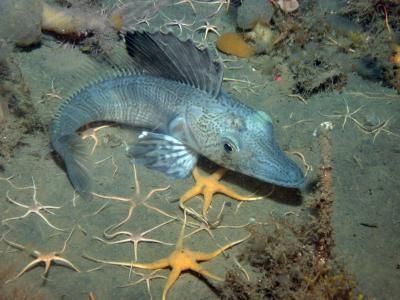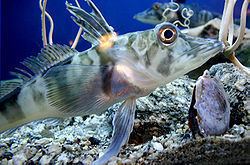Scientific name Notothenioidei Rank Suborder | Phylum Chordata | |
 | ||
Lower classifications | ||
Notothenioidei
Notothenioidei is one of 18 suborders from the order Perciformes and includes Antarctic fish and sub-Antarctic fish. Notothenioids are distributed mainly throughout the Southern Ocean around the coasts of New Zealand, South America, and Antarctica. The main seawater temperatures between −2 and 4 °C (28 and 39 °F), but some the subpolar species inhabit waters that may be as warm as 10 °C (50 °F) around New Zealand and South America. Seawater temperatures below the freezing point of fresh water (0 °C or 32 °F) are possible due to the dissolved salts.
Contents

Notothenioids have a depth range of about 0–1,500 m (0–4,921 ft).
Comparison studies between sub-Antarctic and Antarctic notothenioids have revealed different ecological processes and genetic differences between the two groups of fish, like loss of hemoglobin and changes in buoyancy.

Notothenioidei top 5 facts
Anatomy

The notothenioids lack a swimbladder, and the majority of species are therefore benthic or demersal in nature. However, a depth-related diversification has given rise to some species attaining increased buoyancy, using lipid deposits in tissues and reduced ossification of bony structures. Reduced ossification of the skeleton in the notothenioids changes their weight and henceforth has created neutral buoyancy in the water, where the notothenioid neither sinks nor floats, and can thus adjust depth with ease.

Notothenioids have evolved a variety of interesting physiological and biochemical adaptations that either permit survival in, or are possible only because of, the generally cold, stable seawater temperatures of the Southern Ocean. Many notothenioid fish are able to survive in the freezing, ice-laden waters of the Southern Ocean because of the presence of an antifreeze glycoprotein in blood and body fluids. Although many of the Antarctic species have antifreeze proteins in their body fluids, not all of them do. Some subpolar species either produce no or very little antifreeze, and antifreeze concentrations in some species are very low in young, larval fish.
While the majority of animal species have up to 45% of hemoglobin (or other oxygen-binding and oxygen-transporting pigments) in their blood, the notothenioids of the family Channichthyidae have only 1%. They can still flourish in part because of the high oxygen content of the cold waters of the Southern Ocean and in part because oxygen is absorbed and distributed directly by the plasma. These fish must expend twice as much energy in cardiac output per second than the notothenioids with higher hemoglobin concentration. At a cold temperature, oxygen solubility is greatly increased.
Classification
This classification follows Eastman and Eakin, 2000.
